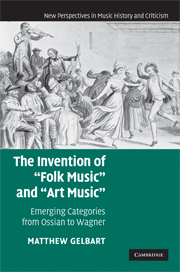Book contents
- Frontmatter
- Contents
- List of music examples
- Acknowledgements
- Introduction
- 1 Function to origin: national identity and national genius emerge, c. 1700–1780
- 2 From pastoral to picturesque: nature, art, and genre in the later eighteenth century
- 3 Genius versus art in the creative process: “national” and “cultivated” music as categories, 1760–1800
- 4 The invention of folk modality, 1775–1840
- 5 “Folk” and “tradition”: authenticity as musical idiom from the late eighteenth century onward
- 6 Organic “art music” and individual original genius: aestheticizing the folk collective
- 7 Local nation and universal folk: the legacy of geography in musical categories
- 8 Folk and art musics in the modern Western world
- Index
5 - “Folk” and “tradition”: authenticity as musical idiom from the late eighteenth century onward
Published online by Cambridge University Press: 22 September 2009
- Frontmatter
- Contents
- List of music examples
- Acknowledgements
- Introduction
- 1 Function to origin: national identity and national genius emerge, c. 1700–1780
- 2 From pastoral to picturesque: nature, art, and genre in the later eighteenth century
- 3 Genius versus art in the creative process: “national” and “cultivated” music as categories, 1760–1800
- 4 The invention of folk modality, 1775–1840
- 5 “Folk” and “tradition”: authenticity as musical idiom from the late eighteenth century onward
- 6 Organic “art music” and individual original genius: aestheticizing the folk collective
- 7 Local nation and universal folk: the legacy of geography in musical categories
- 8 Folk and art musics in the modern Western world
- Index
Summary
The conception of national music was from its earliest days linked closely to another idea: tradition. Tradition was not a long-standing idea waiting to be pressed into service, but was rather a construct coeval with the category of national music: “tradition” too was a component of the new quest for origins. (Thus the common substitution of the term “traditional music” for “folk music” in many contexts during the last two decades of the twentieth century did not entail a major cognitive shift.) In the course of the later eighteenth century, tradition began as a term employed – often derogatorily – to designate and investigate oral transmission itself, but it widened into a more abstract and regulative concept carrying tremendous cultural force.
Many European cultural assets were passed predominantly by oral means until the printing press; and although printing itself brought about a massive social transformation, it took two or three more centuries for “oral” and “literate” culture to be acknowledged as inherently separate entities – with marked characteristics, and profound differences. As Nicholas Hudson points out, the identification of “oral tradition” in its current sense was part of this process; the modern conception of oral tradition was basically an eighteenth-century phenomenon. There was of course not a complete lack of earlier European observation on the differences between speech and writing, even long before the printing press, but until the eighteenth century the word “tradition” continued to be used almost exclusively in the specific domain of the church.
- Type
- Chapter
- Information
- The Invention of 'Folk Music' and 'Art Music'Emerging Categories from Ossian to Wagner, pp. 153 - 190Publisher: Cambridge University PressPrint publication year: 2007

